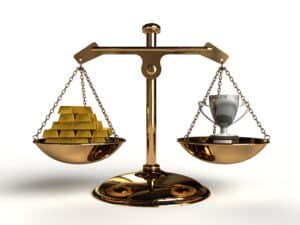401(k)s are the cornerstone for many people’s retirement plans. The 401(k) lets an employee deposit a portion of their paycheck into a retirement account, and their employer may choose to match an agreed-upon percentage of that deposit. These plans can significantly accelerate your savings, leading to more money in your retirement fund and peace of mind about the future.
The Biden 401(k) proposal aims to introduce several changes that affect how retirement accounts and Social Security work, which has led many people to wonder how these changes will affect them. Whether your 401(k) is the only retirement plan you have, or you’ve diversified your retirement savings across multiple investments, understanding what these changes mean is vital for making the right decisions for your retirement goals.
Biden’s Proposed Changes to 401(k) Accounts
It’s easy to overestimate the current administration’s impact on the economy. While it’s common to blame the current president for fuel prices or a weakened economy, the truth is that global factors often play a larger role than the sitting president.
While Biden’s proposal may change how your retirement plans work, it’s best to take the long view regarding your retirement investments. As always, speak to your investment advisor and tax consultant to better understand how these changes affect your situation personally and how you can take advantage of them.
Replacing the Tax Deduction with a Tax Credit
Current 401(k) plans allow employees to invest a percentage of their salary into a 401(k) account and deduct that from their annual tax return.
This method tends to provide the most significant benefit to those with higher incomes—higher earners have higher tax rates and thus get a larger tax deduction from the same investment amount as a lower-earning individual.
For instance, if you earn $70,000 per year and invest $10,000 in a 401(k), you’ll receive a tax saving of $1,200, as your tax rate is 12%. If you earn $450,000 per year, you’ll have a higher tax rate of 35%, which means that if you invest the same $10,000 into a 401(k), you’ll receive a tax saving of $3,500.
The Biden 401(k) proposal suggests replacing the tax dedication with a fixed tax credit of 26% for all 401(k) contributions. This tax credit is the same for everyone, regardless of their earnings. The main advantage of a fixed tax credit is that it allows low- and middle-income families to experience greater retirement benefits and enables higher earners to still receive a relatively generous credit towards their investment.
This tax credit would apply to all employer-matched retirement accounts, including 403(b)s and 457 accounts for individuals working at non-profits, universities, and state and local governments.
Making 401(k) Benefits Available to All Workers
Not all workplaces offer 401(k)s to their employees. According to the 2016 Pew Charitable Trusts report, only 58% of workers have access to a workplace retirement scheme. Millennials and Gen Xers are the least likely to have access to an employer-sponsored plan, but the problem affects individuals from all generations to some extent.
Biden’s plan would create an “automatic 401(k)” for anyone who doesn’t have access to a similar retirement account through their employer. It’s unclear whether this automatic 401(k) would be private- or government-based, but it would allow people to contribute a portion of their salary to a retirement account.
Minimum Benefits
While this portion of the 401(k) proposal doesn’t directly change employer-led retirement savings, it still addresses a glaring issue with Social Security benefits. While most people receive, on average, $1,400 per month on Social Security, many individuals get significantly smaller benefits.
The Biden 401(k) proposal would ensure that Social Security beneficiaries who have worked a minimum of 30 years receive a minimum yearly benefit of 125% of the current poverty level. Relying on Social Security alone won’t allow you to live in luxury, but at least you’ll have peace of mind knowing you’re above the national poverty line.
Increased Benefits for Older Beneficiaries and Catch-Up Contributions
Long-term retirees often struggle financially due to Social Security benefits that don’t keep pace with inflation and increased medical costs. The 401(k) proposal would increase beneficiary benefits, focusing on individuals who have received Social Security for 20 years or more.
Catch-up contributions allow workers over 50 to contribute more to their retirement accounts, including their 401(k). Currently, the government allows individuals over 50 to contribute an additional $5,600 (up to $27,000) as long as they remain in the workforce. The Biden plan would enable caregivers to make similar catch-up contributions even without having earned a formal income for at least a year due to caring for a family member.
Allowing Surviving Spouses to Keep More Benefits
Survivor benefits allow eligible family members to claim their deceased relative’s Social Security benefits.
Currently, surviving spouses are only allowed to claim one set of retirement benefits—if you already claim Social Security benefits yourself, you’ll only receive a survivor benefit if it’s higher than your current benefit. Combined with the reality that Social Security hasn’t kept up with inflation, having a spouse pass away is often a devastating financial blow for affected individuals.
The Biden 401(k) proposal would allow surviving spouses to receive more than just the survivor benefit, reducing the impact of losing half of their household income. The exact details remain unclear, but one suggestion is to increase the monthly payments of affected beneficiaries by 20%.
Ways to Save for Retirement
Relying on one investment method often isn’t enough to ensure a comfortable retirement. Tax-advantaged plans, such as 401(k)s and IRAs, have annual contribution limits, which place a hard cap on how much you can save per year.
One of the significant advantages of retirement plans is their ability to collect compound interest. The more you invest and the longer you save, the larger your eventual rewards. Starting young and investing as much as possible are the keys to saving for retirement successfully.
Diversifying your savings offers several advantages, including:
- Higher contribution limits: You can invest up to $20,500 into a 401(k) in 2022 and up to $6,000 into an IRA. Having both types of accounts gives you almost a 30% increase in how much you can save compared to a single retirement account.
- Protection from economic uncertainty: One of the key components of investing is to avoid putting your eggs into one basket. 401(k) and IRA plans invest in various markets and funds, and their performance depends on how well these investments do. Investing in multiple options ensures that your well-performing investments compensate for any losses, resulting in more steady growth.
Start A 401(k)
A 401(k) is an employer-sponsored, tax-advantaged retirement account. 401(k) contributions are tax-deductible, so any investment in this account results in lower tax payments until you withdraw funds from the account.
Pros:
- Employer-matched contributions
- A high annual contribution limit
- Most 401(k) plan providers offer investment advice
Cons:
- Limited investment options
- No control over plan administration and fees
- High early withdrawal penalties
Open An IRA
Individual retirement accounts (IRAs) allow individuals to take control of their retirement savings. While most IRAs rely on paper investments, some people choose to invest in self-directed IRAs that allow investments in gold or other physical commodities. IRAs come in two options—traditional and Roth.
Traditional IRAs are tax-deferred accounts, meaning that you’ll get a tax deduction for any contributions made into the account (up to a limit of $6,000 per year) and only pay tax when you retire and withdraw your funds.
Roth IRAs work slightly differently, as they don’t provide tax deductions for contributions, but you don’t pay any interest when withdrawing funds when you retire. Roth IRAs don’t have contribution limits like traditional IRAs; instead, you may only contribute to a Roth IRA if you earn between $129.000 and $144,000 individually or $204,000 and $214,000 as a couple.
Pros of traditional IRAs:
- Tax-deferred growth
- Bankruptcy protection
- Tax-deductible contributions
- Few qualifying criteria
Cons of traditional IRAs:
- Taxable disbursement
- Early withdrawal penalties (apart from certain exceptions)
- Low annual contribution limits
Pros of Roth IRAs:
- No tax liability during withdrawal
- No mandatory withdrawals when you reach a certain age
- No maximum age limits for contributions
Cons of Roth IRAs:
- Taxable contributions
- High-income requirements to qualify
- Early withdrawal penalties (apart from certain exceptions)
In addition to Traditional and Roth IRAs, alternative IRAs are becoming very popular with investors that are looking to diversify their retirement savings. For example, at Noble Gold Investments you can open a self-directed IRA backed by gold, silver, and other precious metals. Many investors are flocking to this option as inflation continues to rise around the world and the dollar becomes weaker.
Other Ways To Save For Retirement
In addition to tax-advantaged and government-protected retirement accounts, you can invest directly and independently. Investments allow you greater control over your asset allocation while also ensuring you diversify your holdings as you see fit.
Index Funds
Index funds contain a portfolio that matches or tracks the components of a broader market index, such as the Standard and Poor’s 500 Index or the NASDAQ Composite. While most popular index funds track stock markets, others follow certain asset classes, such as bonds or physical commodities.
These funds are the core of most retirement investment portfolios since they dramatically simplify stock trading. Instead of investing in individual stocks and hoping for the best, index funds let you buy into all of the companies on an index, immediately diversifying your portfolio and reaping stable long-term gains.
Pros:
- Low management expense ratios
- Lower taxes than other investments
- Strong and stable long-term returns
- Perfect for passive investors
Cons:
- Vulnerable to potential market crashes
- Lack of flexibility—no control over which companies you invest in
- Alignment with the market means no potential for high rewards
Mutual Funds
Mutual funds let investors pool their money, which a fund manager then uses to buy and sell securities to meet the goals of the mutual funds. The main appeal of mutual funds is that they streamline the investment process. Instead of having to keep track of and invest in multiple companies, you can invest in a mutual fund that deals in a particular asset class.
Their ease of use has made mutual funds one of the most popular investment vehicles, and they form a large part of many retirement accounts.
Pros:
- Convenient
- Built-in diversity
- Profit reinvestment for rapid growth
- Professional management
Cons:
- High fees
- Trades occur once per day
- Potential for abuse
Exchange-Traded Funds
Exchange-traded funds, or ETFs, are an alternative to mutual funds. Like mutual funds, ETFs buy stocks in various asset classes to meet a particular goal. Investors can buy directly into an ETF on the New York Stock Exchange instead of pooling money to start a mutual fund. Essentially, they’re mutual funds that you can treat like stocks.
Pros:
- Better expense ratios than mutual funds
- Tax efficient
- Can trade ETFs similar to stock trades
Cons:
- Trading costs can become expensive
- Unavailability of fractional shares
- Limited investment mixes
Invest In Precious Metals
Unlike funds, investing in precious metals involves buying a physical commodity, such as gold bars or silver bars. Doing so provides much-needed diversification of your investment portfolio, as precious metals have historically risen in value during times of economic crises. So while your paper investments lose value, your physical investments gain value, ensuring that your retirement account keeps growing.
Pros:
- Protects against inflation
- Portfolio diversification
- Precious metals hold intrinsic value and may rise in value due to increased industrial demand
Cons:
- Expensive to get into
- Do not earn interest over time
- Need secure storage
So Is Your 401(k) Safe While Biden Is In Office?
While the Biden Administration may be making some changes to how 401(k)’s will work, at the end of the day, there is no indication that they plan to steal your retirement savings, kill the 401(k) or make it less advantageous to investors.
However, while the Biden 401(k) proposal offers several benefits to low- and middle-income earners, it doesn’t alleviate the disadvantages associated with a 401(k).
When planning for retirement, one of the best strategies you can follow is diversification. Diversifying your retirement accounts ensures that you accumulate a large nest egg that will keep you comfortable when you stop working.
While paper investments are more common, investing in precious metals can provide added protection during turbulent markets. At Noble Gold Investments, we provide investors with a variety of ways to plan for retirement by purchasing physical precious metals as commodities or even as assets in an IRA.
To find out more about gold and silver IRAs or buying and storing gold as a hedge against inflation, contact the experts at Noble Gold Investments today! We’re ready to answer any questions you may have about precious metals and get your gold and silver IRAs started today.







